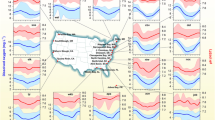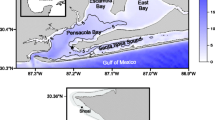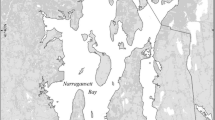Abstract
A central organizing concept in estuarine biogeochemistry is net ecosystem production (NEP). However, estimates of seasonal and interannual variability of whole-system estuarine NEP, which provide insight into how estuaries respond to climatic and anthropogenic forcing, are rare. The main objectives of this study are to (1) determine the seasonal and interannual variability in whole-system NEP of Biscayne Bay, a subtropical, shallow estuary located in southeastern Florida, USA, and (2) determine the potential driving mechanisms of NEP in this estuary. We compute monthly NEP over more than 12 years by constructing the dissolved oxygen budget for the estuary from monthly snapshot oxygen survey data (i.e., collected once per month). High-frequency observations of oxygen in similar subtropical estuaries were used to quantify the error associated with the snapshot monthly sampling. Oxygen air–water exchange and NEP closely balanced each other, with the long-term mean NEP (± 2 standard errors) equal to − 5.3 ± 0.3 mol O2 m−2 year−1, indicating net heterotrophy. Significant seasonality was found, with lowest NEP in September. At monthly time scales, NEP was significantly positively correlated with chlorophyll and total phosphorus and significantly negatively correlated with canal flow. Interannual variability in NEP was substantial, and the bay temporarily shifted from net heterotrophy to net autotrophy after the 2005 Atlantic hurricane season, probably in response to increases in nutrients from runoff and resuspension. These findings show that monthly oxygen surveys can be used to quantify whole-system estuarine NEP and that Biscayne Bay NEP is sensitive to climatic and anthropogenic forcing on seasonal and interannual timescales.






Similar content being viewed by others
References
Bauer, J.E., W.-J. Cai, P.A. Raymond, T.S. Bianchi, C.S. Hopkinson, and P.A.G. Regnier. 2013. The changing carbon cycle of the coastal ocean. Nature 504 (7478): 61–70.
Beck, M.W., J.D. Hagy, and M.C. Murrell. 2015. Improving estimates of ecosystem metabolism by reducing effects of tidal advection on dissolved oxygen time series. Limnology and Oceanography: Methods 13 (12): 731–745. https://doi.org/10.1002/lom3.10062.
Borges, A.V., and G. Abril. 2011. Carbon dioxide and methane dynamics in estuaries. In Treatise on estuarine and coastal science, ed. E. Wolanski and D.S. McLusky, vol. 5, 119–161. Waltham: Academic Press.
Bowman, A.W., and A. Azzalini. 1997. Applied smoothing techniques for data analysis. New York: Oxford University Press.
Brand, L.E. 1988. Assessment of plankton resources and their environmental interactions in Biscayne Bay, Florida. Miami: Metro Dade Department of Environmental Resources Management.
Brand, L.E., M.D. Gottfried, C.C. Baylon, and N.S. Romer. 1991. Spatial and temporal distribution of phytoplankton in Biscayne Bay, Florida. Bulletin of Marine Science 49: 599–613.
Briceño, H.O., and J.N. Boyer. 2006. 2006 annual report of the water quality monitoring project for the water quality protection program of the Florida Keys National Marine Sanctuary. Miami: Southeast Environmental Research Center, Florida International University.
Briceño, H.O., and J.N. Boyer. 2010. Climatic controls on phytoplankton biomass in a sub-tropical estuary, Florida Bay, USA. Estuaries and Coasts 33 (2): 541–553.
Briceño, H.O., J.N. Boyer, J. Castro, and P. Harlem. 2013. Biogeochemical classification of South Florida's estuarine and coastal waters. Marine Pollution Bulletin 75 (1-2): 187–204. https://doi.org/10.1016/j.marpolbul.2013.07.034.
Browder, J.A., R. Alleman, S. Markley, P. Ortner, and P.A. Pitts. 2005. Biscayne Bay conceptual ecological model. Wetlands 25 (4): 854–869. https://doi.org/10.1672/0277-5212(2005)025[0854:BBCEM]2.0.CO;2.
Buzzelli, C., Y. Wan, P. Doering, and J. Boyer. 2013. Seasonal dissolved inorganic nitrogen and phosphorus budgets for two sub-tropical estuaries in south Florida, USA. Biogeosciences 10 (10): 6721–6736.
Caccia, V.G., and J.N. Boyer. 2005. Spatial patterning of water quality in Biscayne Bay, Florida as a function of land use and water management. Marine Pollution Bulletin 50 (11): 1416–1429.
Caccia, V.G., and J.N. Boyer. 2007. A nutrient loading budget for Biscayne Bay, Florida. Marine Pollution Bulletin 54 (7): 994–1008. https://doi.org/10.1016/j.marpolbul.2007.02.009.
Caffrey, J.M. 2004. Factors controlling net ecosystem metabolism in US estuaries. Estuaries and Coasts 27 (1): 90–101.
Caffrey, J.M., M.C. Murrell, K.S. Amacker, J.W. Harper, S. Phipps, and M.S. Woodrey. 2014. Seasonal and inter-annual patterns in primary production, respiration, and net ecosystem metabolism in three estuaries in the Northeast Gulf of Mexico. Estuaries and Coasts 37 (S1): 222–241. https://doi.org/10.1007/s12237-013-9701-5.
Cai, W.-J. 2011. Estuarine and coastal ocean carbon paradox: CO2 sinks or sites of terrestrial carbon incineration? Annual Review of Marine Science 3 (1): 123–145. https://doi.org/10.1146/annurev-marine-120709-142723.
Chapin, F.S., G.M. Woodwell, J.T. Randerson, E.B. Rastetter, G.M. Lovett, D.D. Baldocchi, D.A. Clark, et al. 2006. Reconciling carbon-cycle concepts, terminology, and methods. Ecosystems 9 (7): 1041–1050.
Collado-Vides, L., V. Mazzei, T. Thyberg, and D. Lirman. 2011. Spatio-temporal patterns and nutrient status of macroalgae in a heavily managed region of Biscayne Bay, Florida, USA. Botanica Marina 54: 377–390.
Continental Shelf Associates Inc (1991). A comparison of marine productivity among outer continental shelf planning areas. supplement - an evaluation of benthic habitat primary productivity. A final report for the U.S. Department of the Interior, Minerals Management Service, Herndon, VA. OCS Study MMS 91–0001. Contract No. 14-35-0001-30487. 245 pp. + app.
Curry, J.A., and P.J. Webster. 1999. Thermodynamics of atmospheres and oceans. London: Academic Press.
Emerson, S. 1987. Seasonal oxygen cycles and biological new production in surface waters of the sub-Arctic Pacific Ocean. Journal of Geophysical Research 92 (C6): 6535–6544.
Florida DEP (2002). Biscayne bay ecosummary. Florida Department of Environmental Protection.
Garcia, H.E., and L.I. Gordon. 1992. Oxygen solubility in seawater: Better fitting equations. Limnology and Oceanography 37 (6): 1307–1312.
Herrmann, M., R.G. Najjar, W.M. Kemp, R.B. Alexander, E.W. Boyer, W.-J. Cai, P.C. Griffith, K.D. Kroeger, S.L. McCallister, and R.A. Smith. 2015. Net ecosystem production and organic carbon balance of U.S. East Coast estuaries: A synthesis approach. Global Biogeochemical Cycles 29 (1): 96–111.
Hoellein, T.J., D.A. Bruesewitz, and D.C. Richardson. 2013. Revisiting Odum (1956): A synthesis of aquatic ecosystem metabolism. Limnology and Oceanography 58 (6): 2089–2100.
Hoyer, M.V., T.K. Frazer, S.K. Notestein, and J.D.E. Canfield. 2002. Nutrient, chlorophyll, and water clarity relationships in Florida’s nearshore coastal waters with comparisons to freshwater lakes. Canadian Journal of Fisheries and Aquatic Sciences 59 (6): 1024–1031. https://doi.org/10.1139/f02-077.
Jenkins, W.J., and J.C. Goldman. 1985. Seasonal oxygen cycling and primary production in the Sargasso Sea. Journal of Marine Research 43 (2): 465–491.
Jones, R.D., and J.N. Boyer. 1998. Florida keys national marine sanctuary water quality monitoring project, 1998 annual report. Miami: Southeast Environmental Research Program, Florida International University.
Jørgensen, B.B. 1977. The sulfur cycle of a coastal marine sediment (Limfjorden, Denmark). Limnology and Oceanography 22 (5): 814–832.
Keeling, R.F., B.B. Stephens, R.G. Najjar, S.C. Doney, D. Archer, and M. Heimann. 1998. Seasonal variations in the atmospheric O2/N2 ratio in relation to the kinetics of air-sea gas exchange. Global Biogeochemical Cycles 12 (1): 141–163.
Kemp, W.M., and J.M. Testa. 2011. Chapter 6: Metabolic balance between ecosystem production and consumption. In Treatise on estuarine and coastal science, ed. E. Wolansky and D. McLusky, vol. 7, 83–118. Oxford: Academic Press.
Kemp, W.M., E.M. Smith, M. Marvin-DiPasquale, and W.R. Boynton. 1997. Organic carbon balance and net ecosystem metabolism in Chesapeake Bay. Marine Ecology Progress Series 150: 229–248.
Lirman, D., T. Thyberg, R. Santos, S. Schopmeyer, C. Drury, L. Collado-Vides, S. Bellmund, and J. Serafy. 2014. SAV communities of Western Biscayne Bay, Miami, Florida, USA: Human and natural drivers of seagrass and macroalgae abundance and distribution along a continuous shoreline. Estuaries and Coasts 37 (5): 1243–1255. https://doi.org/10.1007/s12237-014-9769-6.
Lomas, M.W., P.M. Glibert, F.K. Shiah, and E.M. Smith. 2002. Microbial processes and temperature in Chesapeake Bay: Current relationships and potential impacts of regional warming. Global Change Biology 8 (1): 51–70.
Mesinger, F., G. DiMego, E. Kalnay, K. Mitchell, P.C. Shafran, W. Ebisuzaki, D. Jovic, J. Woollen, E. Rogers, and E.H. Berbery. 2006. North American regional reanalysis. Bulletin of the American Meteorological Society 87 (3): 343–360.
Najjar, R.G., and R.F. Keeling. 2000. Mean annual cycle of the air–sea oxygen flux: A global view. Global Biogeochemical Cycles 14 (2): 573–584.
National Centers for Environmental Prediction/National Weather Service/NOAA/U.S. Department of Commerce (2005). Updated monthly. NCEP North American Regional Reanalysis (NARR). Research Data Archive at the National Center for Atmospheric Research, Computational and Information Systems Laboratory. http://rda.ucar.edu/datasets/ds608.0/. Accessed 17 Feb 2017.
Odum, H.T. 1956. Primary production in flowing waters. Limnology and Oceanography 1 (2): 102–117.
Pickard, G.L., and W.J. Emery. 1990. Descriptive physical oceanography: An introduction. Oxford: Pergamon Press.
Ram, A.S.P., S. Nair, and D. Chandramohan. 2003. Seasonal shift in net ecosystem production in a tropical estuary. Limnology and Oceanography 48 (4): 1601–1607. https://doi.org/10.4319/lo.2003.48.4.1601.
Redfield, A.C., B.H. Ketchum, and F.A. Richards. 1963. The influence of organisms on the composition of seawater. In The sea, ed. M.N. Hill, vol. 2, 26–77. New York: Wiley.
Roman, M.R., M.R. Reeve, and J.L. Froggatt. 1983. Carbon production and export from Biscayne Bay, Florida. I. Temporal patterns in primary production, seston and zooplankton. Estuarine, Coastal and Shelf Science 17 (1): 45–59. https://doi.org/10.1016/0272-7714(83)90044-6.
Rudnick, D., Madden, C., Kelly, S., Bennett, R., Cunniff, K. (2007). Appendix 12–3: Report on algal blooms in eastern Florida bay and southern Biscayne Bay. In South Florida Environmental Report - Volume I.
Russell, M.J., and P.A. Montagna. 2007. Spatial and temporal variability and drivers of net ecosystem metabolism in western Gulf of Mexico estuaries. Estuaries and Coasts 30 (1): 137–153.
Russell, M.J., P.A. Montagna, and R.D. Kalke. 2006. The effect of freshwater inflow on net ecosystem metabolism in Lavaca Bay, Texas. Estuarine, Coastal and Shelf Science 68 (1-2): 231–244. https://doi.org/10.1016/j.ecss.2006.02.005.
Sadeghi, S.-H., T.R. Peters, D.R. Cobos, H.W. Loescher, and C.S. Campbell. 2013. Direct calculation of thermodynamic wet-bulb temperature as a function of pressure and elevation. Journal of Atmospheric and Oceanic Technology 30 (8): 1757–1765.
Smith, N.P. 2001. Tides of Biscayne Bay, Card Sound, Barnes sound, and Manatee Bay, Florida. Florida Scientist 64: 224–236.
Smith, S.V., and J.T. Hollibaugh. 1997. Annual cycle and interannual variability of ecosystem metabolism in a temperate climate embayment. Ecological Monographs 67 (4): 509–533.
Smith, S., Buddemeier, R., Wulff, F., Swaney, D., Camacho-Ibar, V., David, L., Dupra, V., Kleypas, J., San Diego-McGlone, M., McLaughlin, C. (2005). C, N, P fluxes in the coastal zone. In C. J. Crossland, H. H. Kremer, H. J. Lindeboom, J. I. Marshall Crossland, M. D. A. Le Tissier (Eds), Coastal fluxes in the Anthropocene (pp. 95–143). Springer.
Swaney, D.P., R.W. Howarth, and T.J. Butler. 1999. A novel approach for estimating ecosystem production and respiration in estuaries: Application to the oligohaline and mesohaline Hudson River. Limnology and Oceanography 44 (6): 1509–1521. https://doi.org/10.4319/lo.1999.44.6.1509.
Swaney, D.P., S.V. Smith, and F. Wulff. 2011. The LOICZ biogeochemical modeling protocol and its application to estuarine ecosystems. In Treatise on estuarine and coastal science, volume 9, ed. E. Wolanski and D.S. McLusky, 136–159. Waltham: Academic Press.
Testa, J.M., and W.M. Kemp. 2008. Variability of biogeochemical processes and physical transport in a partially stratified estuary: A box-modeling analysis. Marine Ecology Progress Series 356: 63–79.
Testa, J.M., W.M. Kemp, W.R. Boynton, and J.D. Hagy. 2008. Long-term changes in water quality and productivity in the Patuxent River estuary: 1985 to 2003. Estuaries and Coasts 31 (6): 1021–1037.
Thorhaug, A., and M. Roessler. 1977. Seagrass community dynamics in a subtropical estuarine lagoon. Aquaculture 12 (3): 253–277.
Tomaso, D., and R. Najjar. 2015. Seasonal and interannual variations in the dissolved oxygen budget of an urbanized tidal river: The Upper Delaware Estuary. Journal of Geophysical Research: Biogeosciences 120 (6): 1027–1045.
Wanninkhof, R. 2014. Relationship between wind speed and gas exchange over the ocean revisited. Limnology and Oceanography: Methods 12 (6): 351–362. https://doi.org/10.4319/lom.2014.12.351.
Wanninkhof, R., W.E. Asher, D.T. Ho, C. Sweeney, and W.R. McGillis. 2009. Advances in quantifying air-sea gas exchange and environmental forcing. Annual Review of Marine Science 1 (1): 213–244.
Yarbro, L.A., and P.R. Carlson. 2011. Seagrass integrated mapping and monitoring for the state of Florida, mapping and monitoring report no. 1. St. Petersburg: Florida Fish and Wildlife Conservation Commission, Fish and Wildlife Research Institute.
Zhang, J.-Z., and C.J. Fischer. 2014. Carbon dynamics of Florida Bay: Spatiotemporal patterns and biological control. Environmental Science & Technology 48 (16): 9161–9169.
Zhang, J.-Z., C.R. Kelble, C.J. Fischer, and L. Moore. 2009. Hurricane Katrina induced nutrient runoff from an agricultural area to coastal waters in Biscayne Bay, Florida. Estuarine, Coastal and Shelf Science 84 (2): 209–218.
Zieman, J.C. 1975. Quantitative and dynamic aspects of the ecology of turtle grass, Thalassia testudinum. In Estuarine research, ed. L.E. Cronin, vol. 1, 541–562. New York: Academic Press.
Acknowledgements
We acknowledge Frank Marshall (Cetacean Logic Foundation, Inc.) and Kate Colna (undergraduate REU student) for their contributions. National Estuarine Research Reserve System (NERRS) data were collected as part of an award from the Estuarine Reserves Division, Office for Coastal Management, National Oceanic and Atmospheric Administration. We thank the principal investigators of the six reserves we used data from: Rebecca Bernard, Mark Woodrey, Nikki Dix, Edward Buskey, Kevin Cunniff, and Scott Phipps.
Funding
This research was supported by The Pennsylvania State University’s Research Experience for Undergraduates (REU) in Climate Science, funded by the National Science Foundation (grant number AGS-1263225), and directed by Jose Fuentes and Jon Nese; and the National Aeronautics and Space Administration’s Carbon Cycle and Ecosystems Program (grant numbers NNX14AM37G and NNX17AH03G).
Author information
Authors and Affiliations
Corresponding author
Additional information
Communicated by Mark J. Brush
Electronic supplementary material
ESM 1
(DOCX 3014 kb)
Rights and permissions
About this article
Cite this article
Seidensticker, L.E., Najjar, R.G., Herrmann, M. et al. Seasonal and Interannual Variability in Net Ecosystem Production of a Subtropical Coastal Lagoon Inferred from Monthly Oxygen Surveys. Estuaries and Coasts 42, 455–469 (2019). https://doi.org/10.1007/s12237-018-0482-8
Received:
Revised:
Accepted:
Published:
Issue Date:
DOI: https://doi.org/10.1007/s12237-018-0482-8




